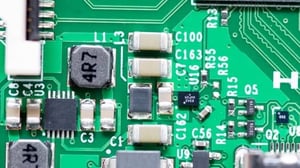
They go together like oil & water, fire & ice, electronics & moisture. Some things just don’t pair well. In this time when electronic components are hard to find, we need to protect the parts we have. All electronic components have a certain level of sensitivity to moisture- some more than others. RBB is working hard to source, store, and protect your PCB assembly and components through all stages of the assembly process. By protecting your assembly from moisture, and watching for moisture issues, we are making sure your mission-critical assemblies are ready to work for you.
Why is Moisture a Problem?
Certain components are sensitive to moisture- and that can cause big problems with your PCB assembly! Problems include functionality and solderability. Solderability problems include how easily the part will solder through the SMT oven, through hold wave oven, or selective solder processes. Moisture can also affect the functionality of the parts, creating contact problems with connectors and IC DIP sockets. Several factors can cause these issues:
- Age: As parts age, they can oxidize over time when exposed to moisture. This process can take years to affect the components. That is why RBB takes every effort to source new or reasonably new parts when possible. When a design requires a part no longer in production, especially if it is moisture sensitive, we take every precaution to make sure the part is stored properly to prevent oxidation.
- Moisture sensitive components: Some components are particularly sensitive to moisture. Parts with a specified moisture level are sensitive due to damage in the heat of the SMT soldering/oven process. Fine pitch SMT IC’s present the most problems, as the solderability in the oven is very reduced.
- Manufacturing Processes: The parts can ‘popcorn’ the absorbed moisture in the part body rapidly heats and cracks open the part, usually ruining it. Parts above a certain moisture level and exposed to heat can crack, like popping corn.
How RBB helps:
RBB is always working to build quality assemblies for our clients, keeping a lookout for potential problems.
There are a few precautions we RBB takes to store your components to keep them safe from oxidation:.png?width=150&name=Untitled%20design%20(2).png)
- Unsealed components can be placed in our dry box. Over time this will remove moisture to a preset level.
- Parts can be baked in the dry bake oven if there is not enough time to dry in the dry box.
- If the parts are not needed immediately, parts can be vacuum sealed and then placed in static shielding bags with desiccant bags and moisture labels to verify the parts are dry. This will maintain the components in a state of reduced moisture until they are needed.
Please note, these precautions will NOT correct oxidation that has already occurred to component leads.
Already exposed to moisture- now what?
If a problem is found – the RBB team moves heaven and earth to make it right.
First, RBB inspects components for oxidation- looking out for any graying of the lead surface.
If oxidation is found and there are no other options for replacement parts, RBB would suggest sending the parts to an IC component re-finishing facility to have the leads replated to improve solderability or to carefully rework the parts.
When reworking, parts are inspected for proper soldering and can be selectively restored using the proper tools such as hot air, a soldering iron, and IR solder station where defects are found.
There may be an additional cost for either process.
Industry Standards
IPC/JEDEC J-STD-020 addresses moisture sensitivity level, the standard approach in determining a package’s (part body type) moisture sensitivity level. There is much that has been written on moisture sensitivity levels (MSL) and there are published standards of requirements for each moisture level.
Many older integrated circuits do not have an MSL level or rating as they were discontinued before the standards were in place.
Through all of this, the goal for RBB is to protect the component, maintain low moisture, and create clean solder connections so your assembly can work for you.





